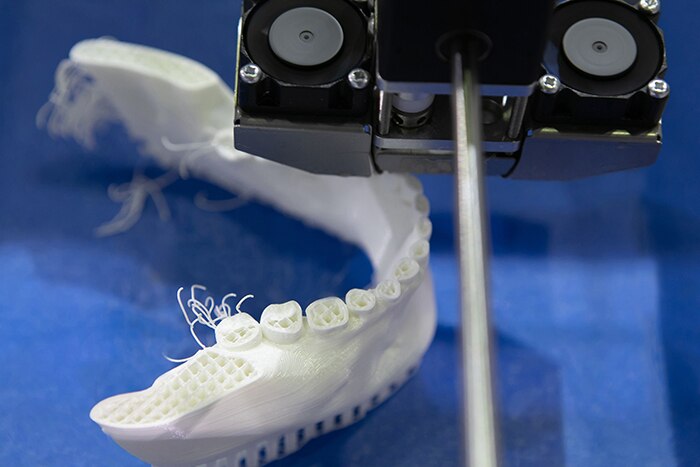3D printing technology has already revolutionized industries like design, engineering, defense and aerospace. In recent years, it’s had a growing impact on the dental profession too. In this article, we discuss the numerous applications, advantages and limitations of 3D printing in dentistry.
How 3D printing works
3D printing, or rapid prototyping, is a form of manufacturing that builds objects one layer at a time, using materials like light curable resins, thermoplastic polymers, metal alloys and ceramics. It’s known as additive manufacturing, because the material is added layer upon layer to create the product, as opposed to commonly used subtractive processes like milling, where material is removed from a solid block of material.
Both 3D printing and milling rely on computer-aided design (CAD) software. Objects can be designed from scratch in the virtual CAD environment, or created using data from computed tomography (CT), cone beam computed tomography (CBCT), or optical surface scans. The completed design is “sliced” into layers, which the 3D printer then lays down one by one to build the physical object.
Applications of 3D printing in dentistry
3D printing only recently entered the mainstream, but dentistry has been making use of this technology for some time now.
Medical modeling of Anatomy
One of the most established applications is medical/surgical modeling of anatomy, supported by the widespread availability of CT and CBCT images. This makes it possible to replicate complex or atypical anatomy, giving surgeons the opportunity to better treatment plan and refine their approach.
In endodontics, 3D printing can be used to create custom tooth models, improving visualization of and access to canal spaces, and facilitating more accurate, effective treatment by offering a treatment planning (and practice) option for a given case. Medical models can also be used in dental training and education, offering a safe and realistic way for students to gain anatomical knowledge and practical experience.
Orthodontic appliances
Discreet, removable aligners have emerged as a popular alternative to fixed orthodontic appliances ('braces'), and an intraoral scanner, virtual impressions and then 3D printing is used to create the series of aligners.
Other orthodontic applications include the bending of wires, or the creation of indirect bracket-bonding splints in multiple materials.
Surgical guides
3D printing is increasingly used to create drilling and cutting guides, particularly in implant and maxillofacial procedures. CAD-generated 3D plans can be transferred to the operative site, allowing the precise placement required.
Dental prostheses
Traditionally, prostheses were painstakingly created in a laboratory by skilled dental technicians, based on physical impressions that were usually uncomfortable for the patient. Now, a virtual impression can be obtained using intraoral and extraoral scanners, based on which a prosthesis can be designed in CAD software and printed with a 3D printer – all within the dental clinic. Examples of applications include denture bases and artificial teeth, as well as implant abutments.
Metal structures can be printed directly, while a more popular and cost-effective approach is to 3D-print wax or resin casts to create metal structures.
Maxillofacial prostheses
Oral, nasal and orbital maxillofacial prosthesis are often required for post-surgical rehabilitation. The use of scanners in conjunction with 3D printing provides a more comfortable experience for the patient and a more accurate prosthetic fit.
Tissue augmentation
Where there is insufficient bone to support an implant, 3D printing can be used for bone augmentation. Scaffolds can be printed with biomaterials like polymers, infused with stem cells and placed at precise locations to encourage bone generation. Another example is the placement of biomaterial scaffolding containing mesenchymal stem cells over alveolar bone defects caused by periodontal disease. This procedure has been shown to support regeneration of periodontal tissue.
3D-printed grafts are also used for soft tissue regeneration. They can be used to improve root coverage in cases of gingival recession, augment keratinized tissue, and cover large soft tissue defects with accuracy and improved healing time compared to traditional methods.
Advantages and limitations of 3D printing
Cost and efficiency are advantages of 3D printing compared to milling. A 3D printer costs significantly less than a milling unit, and in-house 3D printing saves time and money. While there are the initial cost of purchasing a 3D printer, and ongoing materials costs, 3D printing allows you to produce the required products on demand, saving the time associated with outsourcing to a lab and there are no laboratory costs.
While the range of materials that can be used in milling is extensive, the process is slow - and wasteful as much of the milling block is discarded. 3D printing is more efficient and accurate, particularly in the creation of complex structures.
However, there are also limitations to 3D printing. Milling blocks are made under optimized conditions, giving greater homogeneity than 3D printing. Some clinicians say that this offers stronger restorations, with lower porosity and risk of deformation, better optical properties for esthetics, and greater resistance to bacterial adhesion.
At present, many clinicians are combining the two technologies to enjoy the best of both worlds. For example, they can be used together to create complex implant bridge structures with little waste (courtesy of 3D printing) and featuring high-precision mechanical connecting surfaces (courtesy of milling). As 3D printing continues to advance, it remains to be seen whether it will replace milling for indications where both technologies are currently used.
These are just some of the many applications and advantages of 3D printing, with many more exciting developments currently in the experimental phase. For further reading, you may find the following extended articles of interest:
3D and 4D printing in dentistry and maxillofacial surgery: Recent advances and future perspectives


Was this article helpful?
If you’d like a response, Contact Us.